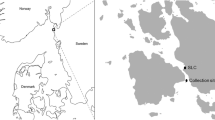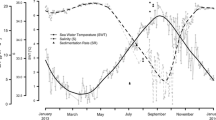Abstract
Macroalgae, in particular kelps, produce a large amount of biomass in Kongsfjorden, which is to a great extent released into the water in an annual cycle. As an example, the brown alga Alaria esculenta loses its blade gradually, 3 ± 0.8 % of the blade area per day (August 2012), thereby adding to the pool of particulate organic matter (POM) in the fjord. Upon release small thallus pieces are “aging” in that they are prone to leaching and serving as substrate for microorganisms, thus turning into palatable food for suspension and bottom feeders. In order to define a macroalgal baseline for the Kongsfjorden food web, stable isotopes δ14C and δ15N were measured in individuals of A. esculenta, Saccharina latissima and Laminaria digitata directly sampled after collection and in artificially produced POM (aPOM) of A. esculenta that was allowed to age under experimental conditions. In aPOM from this species sampled in August 2012 the C/N ratios decreased between d1 and d8 of a 14-day culture period in parallel to the fading photosynthetic activity of the algal fragments as demonstrated by use of an Imaging-PAM. Microscopic observations of the aPOM in August 2012 and 2013 revealed the frequent occurrence of small brown algal endo- and epiphytes. First feeding experiments with Mysis oculata (Mysids) and Hiatella arctica (Bivalves) showed that these species can ingest macroalgal POM. The importance of kelp-derived POM for the food web is subject of the current research.







Similar content being viewed by others
References
Bartsch I, Paar M, Fredriksen S, Schwanitz M, Daniel C, Wiencke C (2015) Changes in kelp forest biomass and depth distribution in Kongsfjorden (Spitsbergen) between 1996–1998 and 2012–2014 reflect Arctic warming. Polar Biol (in review)
Brouwer PEM (1996) Decomposition in situ of the sublittoral Antarctic macroalga Desmarestia anceps montagne. Polar Biol 16:129–137
Bustamante RH, Branch GM (1996) The dependence of intertidal consumers on kelp-derived organic matter on the west coast of South Africa. J Exp Mar Biol Ecol 196:1–28
Dethier MN, Brown AS, Burgess S, Eisenlord ME, Galloway AWE, Kimber J, Lowe AT, O’Neil CM, Raymond WW, Sosik EA, Duggins DO (2014) Degrading detritus: changes in food quality of aging kelp tissue varies with species. J Exp Mar Biol Ecol 460:72–79
Dexter KF, Scheibling RE (2012) Hurricane-mediated defoliation of kelp beds and pulsed delivery of kelp detritus to offshore sedimentary habitats. Mar Ecol Prog Ser 455:51–64
Duarte CM, Cebrián J (1996) The fate of marine autotrophic production. Limnol Oceanogr 41:1758–1766
Duggins DO, Eckman JE (1997) Is kelp detritus a good food for suspension feeders? Effects of kelp species, age and secondary metabolites. Mar Biol 128:489–495
Duggins DO, Simenstad CA, Estes JA (1989) Magnification of secondary production by kelp detritus in coastal marine ecosystems. Science 245:170–173
Dunton KH (2001) δ13C and δ15N measurements of antarctic peninsula fauna: trophic relationships and assimilation of benthic seaweeds. Am Zool 41:99–112
Dunton KH, Schell DM (1987) Dependence of consumers on macroalgal carbon (Laminaria solidungula) in an arctic kelp community. δ13C evidence. Mar Biol 93:615–625
Fischer G, Wiencke C (1992) Stable carbon isotope composition, depth distribution and fate of macroalgae from the Antarctic Peninsula region. Polar Biol 12:341–348
Folin O, Ciocalteu V (1927) On tyrosine and tryptophane determinations in proteins. J Biol Chem 73:627–650
Fredriksen S (2003) Food web studies in a Norwegian kelp forest based on stable isotope (δ13C and δ15N) analysis. Mar Ecol Prog Ser 260:71–81
Fredriksen S, Bartsch I, Wiencke C (2014) New additions to the benthic marine flora of Kongsfjorden, western Svalbard, and comparison between 1996/1998 and 2012/2013. Bot Mar 57:203–216
Goecke F, Labes A, Wiese J, Imhoff JF (2010) Chemical interactions between marine macroalgae and bacteria. Mar Ecol Prog Ser 409:267–299
Hop H, Wiencke C, Vögele B, Kovaltchouk N (2012) Species composition, zonation, and biomass of marine benthic macroalgae in Kongsfjorden, Svalbard. Bot Mar 55:399–414
Kaehler S, Pakhomov EA, McQuaid CD (2000) Trophic structure of the marine food web at the Prince Edward Islands (Southern Ocean) determined by δ13C and δ15N analysis. Mar Ecol Prog Ser 208:13–20
Kaehler S, Pakhomov EA, Kalin RM, Davis S (2006) Trophic importance of kelp-derived suspended particulate matter in a through-flow sub-Antarctic system. Mar Ecol Prog Ser 316:17–22
Kain JM (1989) The seasons in the subtidal. Br Phycol J 24:203–215
Kelly JR, Krumhansl KA, Scheibling RE (2012) Drift algal subsidies to sea urchins in low-productivity habitats. Mar Ecol Prog Ser 452:145–157
Krumhansl KA, Scheibling RE (2011) Detrital production in Nova Scotian kelp beds: patterns and processes. Mar Ecol Prog Ser 421:67–82
Krumhansl KA, Scheibling RE (2012) Production and fate of kelp detritus. Mar Ecol Prog Ser 467:281–302
Krumhansl KA, Lauzon-Guay JS, Scheibling RE (2014) Modeling effects of climate change and phase shifts on detrital production of a kelp bed. Ecology 95:763–774
Leclerc JC, Riera P, Leroux C, Lévêque L, Laurans M, Schaal G, Davoult D (2013a) Trophic significance of kelps in kelp communities in Brittany (France) inferred from isotopic comparisons. Mar Biol 160:3249–3258
Leclerc JC, Riera P, Leroux C, Lévêque L, Davoult D (2013b) Temporal variation in organic matter supply in kelp forests: linking structure to trophic functioning. Mar Ecol Prog Ser 494:87–105
Levinton JS, Ward JE, Shumway SE (2002) Feeding responses of the bivalves Crassostrea gigas and Mytilus trossulus to chemical composition of fresh and aged kelp detritus. Mar Biol 141:367–376
Mann KH (1973) Seaweeds: their productivity and strategy for growth. Science 182:975–981
Mann KH (1988) Production and use of detritus in various freshwater, estuarine, and coastal marine ecosystems. Limnol Oceanogr 33:910–930
McMeans BC, Rooney N, Arts MT, Fisk AT (2013) Food web structure of a coastal Arctic marine ecosystem and implications for stability. Mar Ecol Prog Ser 482:17–28
Miller RJ, Page HM (2012) Kelp as a trophic resource for marine suspension feeders: a review of isotope-based evidence. Mar Biol 159:1391–1402
Norderhaug KM, Fredriksen S, Nygaard K (2003) Trophic importance of Laminaria hyperborea to kelp forest consumers and the importance of bacterial degradation to food quality. Mar Ecol Prog Ser 255:135–144
Norderhaug KM, Nygaard K, Fredriksen S (2006) Importance of phlorotannin content and C:N ratio of Laminaria hyperborea in determining its palatability as food for consumers. Mar Biol Res 2:367–371
Norwegian Polar Institute, Map of Svalbard http://toposvalbard.npolar.no/?lang=en
Olischläger M, Wiencke C (2013) Seasonal fertility and combined effects of temperature and UV-radiation on Alaria esculenta and Laminaria digitata (Phaeophyceae) from Spitsbergen. Polar Biol 36:1019–1029
Orr KK, Wilding TA, Horstmeyer L, Weigl S, Heymans JJ (2014) Detached macroalgae: its importance to inshore sandy beach fauna. Estuar Coast Shelf Sci 150:125–135
Page HM, Reed DC, Brzezinski MA, Melak JM, Dugan JE (2008) Assessing the importance of land and marine sources of organic matter to kelp forest food webs. Mar Ecol Prog Ser 360:47–62
Renaud PE, Tessmann M, Evenset A, Christensen GN (2011) Benthic food-web structure of an Arctic fjord (Kongsfjorden, Svalbard). Mar Biol Res 7:13–26
Renaud PE, Løkken TS, Jørgensen LL, Berge J, Johnson BJ (2015) Macroalgal detritus and food-web subsidies along an Arctic fjord depth-gradient. Front Mar Sci 2:31. doi:10.3389/fmars.2015.00031
Schaal G, Riera P, Leroux C (2010) Trophic ecology in a Northern Brittany (Batz Island, France) kelp (Laminaria digitata) forest, as investigated through stable isotopes and chemical assays. J Sea Res 63:24–35
Schaal G, Riera P, Leroux C (2012) Food web structure within kelp holdfasts (Laminaria): a stable isotope study. Mar Ecol 33:370–376
Schiener P, Black KD, Stanley MS, Green DH (2015) The seasonal variation in the chemical composition of the kelp species Laminaria digitata, Laminaria hyperborea, Saccharina latissima and Alaria esculenta. J Appl Phycol 27:363–373
Sokołowski A, Szczepańska A, Richard P, Kędra M, Wołowicz M, Węsławski JM (2014) Trophic structure of the macrobenthic community of Hornsund, Spitsbergen, based on the determination of stable carbon and nitrogen isotopic signatures. Polar Biol 37:1247–1260
Sosik EA, Simenstad CA (2013) Isotopic evidence and consequences of the role of microbes in macroalgae detritus-based food webs. Mar Ecol Prog Ser 494:107–119
Van Alstyne KL, McCarthy JJ III, Hustead CL, Kearns LJ (1999) Phlorotannin allocation among tissues of northeastern Pacific kelps and rockweeds. J Phycol 35:483–492
Wahl M, Goecke F, Labes A, Dobretsov S, Weinberger F (2012) The second skin: ecological role of epibiotic biofilms on marine organisms. Front Microbiol 3:292. doi:10.3389/fmicb.2012.00292
Wessels H, Hagen W, Molis M, Wiencke C, Karsten U (2006) Intra- and interspecific differences in palatability of Arctic macroalgae from Kongsfjorden (Spitsbergen) for two benthic sympatric invertebrates. J Exp Mar Biol Ecol 329:20–33
Yorke CE, Miller RJ, Page HM, Reed DC (2013) Importance of kelp detritus as a component of suspended particulate organic matter in giant kelp Macrocystis pyrifera forests. Mar Ecol Prog Ser 493:113–125
Zielinski K (1981) Benthic macroalgae of Admiralty Bay (King George Island, South Shetland Islands) and circulation of algal matter between the water and the shore. Pol Polar Res 2:71–94
Acknowledgments
This research was performed at the Ny Alesund International Research and Monitoring Facility on Spitsbergen (Svalbard) as part of the KOL 06 long term project. We are grateful for the logistic support from all AWIPEV teams. We wish to thank Max Schwanitz and several AWI diving teams for reliably supplying us with macroalgae. Martin Graeve and Benoit Lebreton deserve thanks for analyzing stable isotopes and for the additional effort of intercalibration. Ines Stuhldreier and Ulrike Dietrich were dedicated and cheerful student helpers at Ny Alesund. Claudia Daniel was a great relief with all the tedious laboratory work. Michael Greenacre, Paul Renaud and two more anonymous reviewers helped to improve the manuscript. We highly appreciate the time they invested and their good advice!
Author information
Authors and Affiliations
Corresponding author
Additional information
This article belongs to the special issue on the “Kongsfjorden ecosystem—new views after more than a decade of research”, coordinated by Christian Wiencke and Haakon Hop.
Electronic supplementary material
Below is the link to the electronic supplementary material.
Rights and permissions
About this article
Cite this article
Buchholz, C.M., Wiencke, C. Working on a baseline for the Kongsfjorden food web: production and properties of macroalgal particulate organic matter (POM). Polar Biol 39, 2053–2064 (2016). https://doi.org/10.1007/s00300-015-1828-3
Received:
Revised:
Accepted:
Published:
Issue Date:
DOI: https://doi.org/10.1007/s00300-015-1828-3




